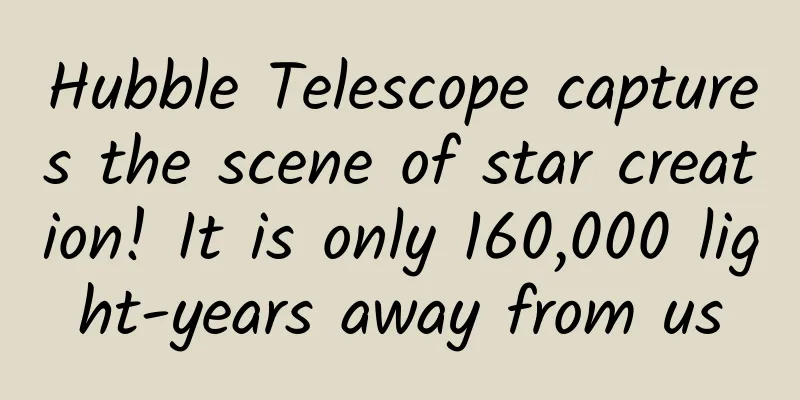Hubble Telescope captures the scene of star creation! It is only 160,000 light-years away from us

|
The Hubble Space Telescope captured this view of star creation, located near the outskirts of the famous Tarantula Nebula. This nebula of gas and dust, and the many young massive stars surrounding it, is a perfect laboratory to study the birth of massive stars. The bright pink nebula and the young stars surrounding it in this image taken by the NASA/ESA Hubble Space Telescope are named LHA 120-N150. This region of space is located on the outskirts of the Tarantula Nebula, one of the largest stellar nurseries known in the universe. The nebula is located more than 160,000 light-years away in the Large Magellanic Cloud, an irregular dwarf galaxy orbiting the Milky Way. The Large Magellanic Cloud has had one or more close encounters in the past, possibly with the Small Magellanic Cloud. These interactions have caused an episode of energetic star formation in our tiny neighbor, part of which can be seen as the Tarantula Nebula. Also known as 30 Doradus or NGC 2070, the Tarantula Nebula gets its name from the arrangement of bright patches that somewhat resemble the legs of a tarantula. At nearly 1,000 light-years in diameter, the Tarantula Nebula feels close at hand, and its favorable inclination to the Large Magellanic Cloud, as well as the absence of intervening dust, makes the Tarantula Nebula one of the best laboratories for studying the formation of stars, especially massive stars. The Tarantula Nebula hosts an unusually high density of massive stars, often referred to as superclusters. Astronomers studied LHA120-N150 to learn more about the environments in which massive stars form. Theoretical models of massive star formation suggest that they should form within star clusters; but observations suggest that up to 10% of massive stars form in isolation. The giant Tarantula Nebula and its numerous substructures are the perfect laboratory for unraveling this mystery, because within it, massive stars can be found both as members of clusters and as isolated stars. With the help of Hubble, astronomers are trying to figure out whether the isolated stars visible in the nebula truly formed individually, or simply left their stellar siblings. However, such studies are not an easy task, as young stars, especially massive ones, look very similar to dense dust before they are fully formed. LHA 120-N 150 contains dozens of such objects, a mixture of possible young stellar bodies and others that may be dust clumps. Only detailed analysis and observations will reveal their nature, which will help to finally resolve the unresolved question of the origin of massive stars. Hubble has observed the Tarantula Nebula and its substructures in the past, and astronomers are very interested in the formation and evolution of stars. The findings are published in the Astrophysical Journal. The observations show that a significant fraction of O stars in the Milky Way field of view appear to have formed in isolation or as low-mass clusters (8${M}_{\ODOT}$) of young stars (MYSO). The observations show that although these young stars are far away from other clusters nebulae and even known giant molecular clouds, they are actually not isolated at all. Bokeyuan|www.bokeyuan.net Bo Ke Yuan | Research/From: ESA/Hubble Information Center Reference journal: Astrophysics DOI: 10.3847/1538-4357/834/1/94 BoKeYuan|Science, technology, research, popular science Follow [Bokeyuan] to see more beautiful cosmic science |
<<: What is a nuclear submarine? How is it different from a normal submarine?
>>: Beijing's new coronavirus sequence released
Recommend
This inconspicuous country has produced the most outstanding group of people in the history of science
Among the winners of the 2023 Nobel Prize in Phys...
Want to fly to the sky and walk shoulder to shoulder with the sun? China has a plan!
Regarding China's future deep space explorati...
The effect of black and white
Although Heichou and Baichou have different names...
The efficacy and function of silkworm sand
The medical value of silkworm excrement is beyond...
Why did he almost lose his life just because he was cutting his nose hair?
Many people like to trim their nose hairs, becaus...
Can eating ginkgo nuts cure diabetes? Can soaking ginkgo leaves in water lower blood pressure and blood lipids? Improper consumption may...
gossip Ginkgo is a perennial woody plant of the G...
Is it true that food nowadays is not as delicious as before?
In the past, when food resources were scarce, it ...
The efficacy and function of Qijingu
What are the functions of Qijingu? As a tradition...
my country has officially entered the flood season. Here’s what to do when encountering flood disasters →
The Ministry of Water Resources announced on Apri...
Attention! If this kind of liquid flows out of your nasal cavity, it may be that your brain is "leaking"
Tuchong Creative In daily life, when we make mist...
Why did such an ordinary little sand pit cause him to fall and die?
Perhaps you often see these small pits in the san...
Dumplings are the perfect staple food! But many people may have been eating them wrong...
Dumplings play an important role in Chinese peopl...
The efficacy and function of Zishi
Zizishi is a traditional Chinese medicine. In add...
Can calcium supplementation be used to treat calcium deficiency? The calcium tablets you swallow may not have entered your bones!
Author: Qu Tiebing, Chief Physician, Beijing Boai...









